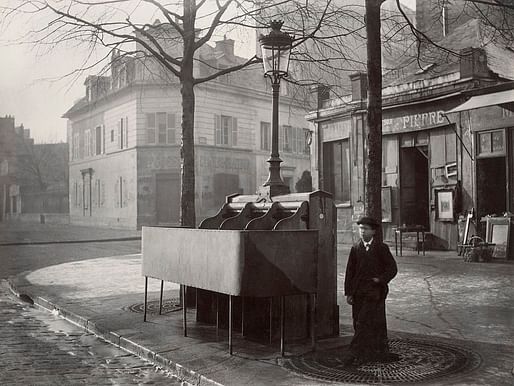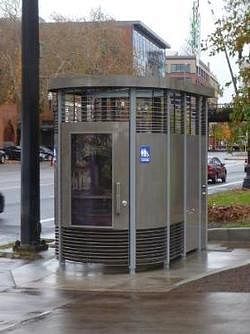

In the U.S., homeless-rights advocates say that in most cities it is difficult to find public toilets — making sanitation an issue that homeless people face on a daily basis [...] Even if there are public bathrooms, many are not open around the clock, leaving the homeless with no other option but to go in public areas — an act that is criminalized in most cities. Critics say such policies unfairly punish homeless people for life-sustaining actions. — Al Jazeera
Often restricted private bathrooms in restaurants or cafes, homeless people have very few options but to defecate in public – a dehumanizing and unsanitary situation. American cities are not particularly well-known for creating infrastructure and urban furniture that accommodates their sizeable homeless populations. Often designers are complicit in creating exclusionary devices rather than using their skills to open the city and make it more livable for even the most marginalized populations. Last month, we looked at unwelcoming bench designs as a tactic of exclusion as well as various counter-designs. The city of Santa Monica should be added to that list, after replacing benches at Big Blue Bus stations with stools designed by Lorcan O'Herlihy Architects. The uncomfortable stools, pictured below, have caused a small controversy. Big Blue Bus explicitly admitted they were intended to prevent "loitering."

Like loitering laws that criminalize a basic, life-sustaining activity (sleeping), public defecation laws, while certainly sensible and necessary, likewise criminalize an act without providing solutions. The Al Jazeera article argues for laws that open private bathrooms to anyone, as well as the return of washroom attendants (a common sight in the 1950s and 60s), which would provide both cleanliness and job opportunities.
Sanisettes – or Saniloos in the UK – are self-cleaning public toilets that are a common sight in Paris or other cities. These self-contained, unisex toilets automatically clean themselves after each use. Parisian Sanisettes were originally pay-toilets but, largely to accommodate use by homeless people, have since been converted and are free throughout the city. The Sanisette is a development of pissoirs, the public urinals that were once ubiquitous throughout many European cities and can still often be found. While there are certainly some interestingly-designed pissoirs, they are both gendered and restricted to urinating.

The Pacific Northwest seems to be doing something right. The City of Portland's "Portland Loos" started implementing public, flushing toilets with adjacent sinks back in 2008. They toilets are cleaned twice daily and are accessible 24 hours a day, which is rare for many public toilets and a vital necessity. Additionally, students in the urban studies program at Portland State University helped raise awareness of the "right to relief" by gathering video testimonies from homeless people as well as creating a map to serve as a guide to public restrooms in the city.

Some students have attempted to develop design solutions to the problem of public, free toilets for the homeless. At the University of Washington, students responded to a prompt by the Seattle Housing and Resource Effort, or SHARE, a nonprofit that works with the homeless. They created a portable, environmentally-friendly toilet out of found and donated materials, specifically, six wooden pallets, two plastic jugs and burlap bags. These structures can be assembled in less than five minutes. Rather than using water and plumbing, these are compost toilets, which, in addition to their rustic, handmade aesthetic makes it hard to imagine they would be readily rolled out on a large scale.

Another project by UW students was tailored to the Ballard neighborhood of Seattle, which houses and estimated 50 "homeless car campers." These designs, which include showers and toilets in their "hygiene stations," are specifically for encampments of 3-4 cars. They include fences which can be shut at night to provide security. It looks like this project was actually intended to be implemented and was met with some controversy, but I can't find recent updates on the program. If you have any information, please get in contact.

Do you know of any other design projects intended to tackle the issue of toilets for the homeless? We'd love to hear about them.
For a different look at the relationship between architecture and defecation, check out Shitting Architecture: the dirty practice of waste removal.
No Comments
Block this user
Are you sure you want to block this user and hide all related comments throughout the site?
Archinect
This is your first comment on Archinect. Your comment will be visible once approved.